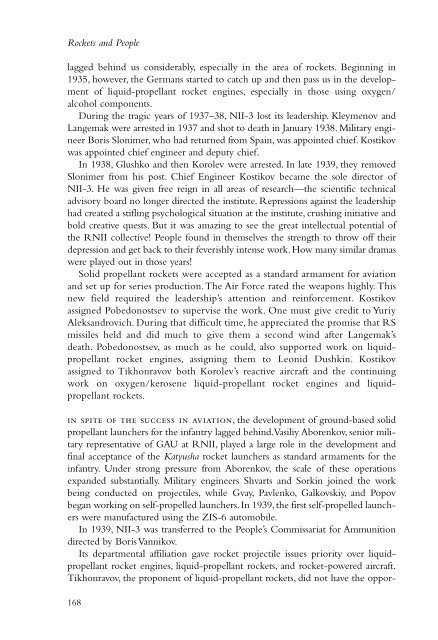to open next chapter. - NASA's History Office
to open next chapter. - NASA's History Office
to open next chapter. - NASA's History Office
You also want an ePaper? Increase the reach of your titles
YUMPU automatically turns print PDFs into web optimized ePapers that Google loves.
Rockets and People<br />
lagged behind us considerably, especially in the area of rockets. Beginning in<br />
1935, however, the Germans started <strong>to</strong> catch up and then pass us in the development<br />
of liquid-propellant rocket engines, especially in those using oxygen/<br />
alcohol components.<br />
During the tragic years of 1937–38, NII-3 lost its leadership. Kleymenov and<br />
Langemak were arrested in 1937 and shot <strong>to</strong> death in January 1938. Military engineer<br />
Boris Slonimer, who had returned from Spain, was appointed chief. Kostikov<br />
was appointed chief engineer and deputy chief.<br />
In 1938, Glushko and then Korolev were arrested. In late 1939, they removed<br />
Slonimer from his post. Chief Engineer Kostikov became the sole direc<strong>to</strong>r of<br />
NII-3. He was given free reign in all areas of research—the scientific technical<br />
advisory board no longer directed the institute. Repressions against the leadership<br />
had created a stifling psychological situation at the institute, crushing initiative and<br />
bold creative quests. But it was amazing <strong>to</strong> see the great intellectual potential of<br />
the RNII collective! People found in themselves the strength <strong>to</strong> throw off their<br />
depression and get back <strong>to</strong> their feverishly intense work. How many similar dramas<br />
were played out in those years!<br />
Solid propellant rockets were accepted as a standard armament for aviation<br />
and set up for series production.The Air Force rated the weapons highly. This<br />
new field required the leadership’s attention and reinforcement. Kostikov<br />
assigned Pobedonostsev <strong>to</strong> supervise the work. One must give credit <strong>to</strong> Yuriy<br />
Aleksandrovich. During that difficult time, he appreciated the promise that RS<br />
missiles held and did much <strong>to</strong> give them a second wind after Langemak’s<br />
death. Pobedonostsev, as much as he could, also supported work on liquidpropellant<br />
rocket engines, assigning them <strong>to</strong> Leonid Dushkin. Kostikov<br />
assigned <strong>to</strong> Tikhonravov both Korolev’s reactive aircraft and the continuing<br />
work on oxygen/kerosene liquid-propellant rocket engines and liquidpropellant<br />
rockets.<br />
in spite of the success in aviation, the development of ground-based solid<br />
propellant launchers for the infantry lagged behind.Vasiliy Aborenkov, senior military<br />
representative of GAU at RNII, played a large role in the development and<br />
final acceptance of the Katyusha rocket launchers as standard armaments for the<br />
infantry. Under strong pressure from Aborenkov, the scale of these operations<br />
expanded substantially. Military engineers Shvarts and Sorkin joined the work<br />
being conducted on projectiles, while Gvay, Pavlenko, Galkovskiy, and Popov<br />
began working on self-propelled launchers. In 1939, the first self-propelled launchers<br />
were manufactured using the ZIS-6 au<strong>to</strong>mobile.<br />
In 1939, NII-3 was transferred <strong>to</strong> the People’s Commissariat for Ammunition<br />
directed by Boris Vannikov.<br />
Its departmental affiliation gave rocket projectile issues priority over liquidpropellant<br />
rocket engines, liquid-propellant rockets, and rocket-powered aircraft.<br />
Tikhonravov, the proponent of liquid-propellant rockets, did not have the oppor-<br />
168
















